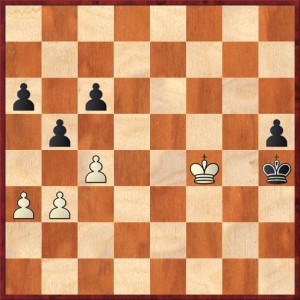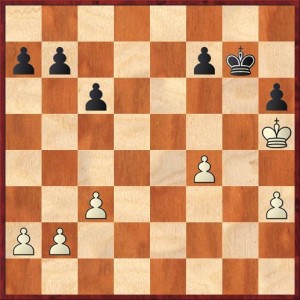This is the 500th post on “dana blogs chess”! In honor of the occasion, I am posting a recap of my first tournament, the 1972 Indiana State Closed Chess Championship, which was played at Bernard Parham’s chess studio in West Lafayette, Indiana. See post no. 499 for the first half of the story.
Let me repeat my disclaimer from last time: I was thirteen years old when I wrote this, and I did not always say things as tactfully as I would today. So if anyone is offended by anything I wrote — well, first, I apologize, and second, I hope you’ll cut me some slack because I was so young at the time. And in case it isn’t obvious, I really loved the characters and personalities I encountered at this tournament and others. Why else would I have kept on playing chess?
And now let’s set our Way-Back Machine for June 18, 1972 …
Homer Peterson was one of the most laughable characters in the tournament. He was an enormously fat man who could not walk — he waddled with his head swaying from side to side… When playing chess he looked even more ludicrous, his mouth opening and closing like a guppy’s and his head shaking back and forth and hanging out over the board. His mouth was always turned down at the corners like the mouth of a bulldog.
Mr. Peterson also obviously felt he was a big shot. Charging — er, waddling into the “normal room” where all the players who were on time were conducting the election of officers for the Indiana State Chess Association, he said in a loud voice, “I demand to know what has happened here because this man and I are late.” Then there was the incident where he was to decide whether to take a trophy or a book for finishing second in Class A. … He looked over all the books and decided none suited his “refined” taste. So he grudgingly went over to the trophies and carefully scrutinized each one for attractiveness and shininess. (One witness razzed him, “Why don’t you get a light meter, Homer?”) Finally, after putting on his act, he gruffly walked off with one of the trophies.
The fourth round… was a wonderful round because all three of us [Editor’s note: Blaise Morton, Joel Boaz and I] managed to win. … Unfortunately, I did not have the satisfaction of playing an errorless game because, as the man in the Band-Aid (Footnote: His hair was extremely short on the back and sides of his head, but stuck up two inches or so on top. He had a large Band-Aid prominently displayed on his cheek) pointed out, my opponent could have forked my knight and bishop on the seventh move. Well, at least I won…
Blaise’s win this round was probably his greatest accomplishment of the tournament. Playing a 1740-rated opponent, he played flawless chess until the last move, gradually building up an attack on his opponent’s castled position and, despite facing accurate defense, crashing through with a bishop sacrifice to win the game. Though his followup was not quite exact, he still had a won game and his opponent resigned.
Now the climactic meeting (for Blaise) was set up. He would play Mike Gant for the unrated-class and junior state championship. Unfortunately, it turned out that the latter was not necessarily true. Albert Chao, a class D player, had piled up 2½ points… Blaise and Mike had three. But Chao had more tie-break points (sum of total wins after each round) than either — and this proved to be crucial.
Unfortunately, Blaise knew none of this (and neither did Gant). … Blaise was Black, and he played the Ruy Lopez. He played a fast-simplifying line, and they reduced to six pawns apiece. After they traded pawns, Gant claimed a draw. Blaise, though he knew he had a win, accepted it because he knew he was ahead of Gant on tie-break points.
Albert Chao also won. Chao, Morton and Gant each had 3½ points… Because Blaise did not know about Chao, because he accepted a draw to get 3½ points instead of 4 — by that narrow line, he was not the state junior champion.
[Editor’s Note: The comment about Gant “claiming” a draw was surely inaccurate, as I did not yet understand the mechanism of draw offers. I’m sure that Gant offered it and Blaise accepted.
It really is true, however, that Blaise agreed to a draw in a won position and that this cost him the junior championship. Here is the final position:
If you took away the queenside pawns it would be a draw, but with the queenside pawns it’s an elementary win. For example, 1. … bc 2. bc c5 would work fine. White has to allow Black’s king to escape the h-file, and if White goes after the queenside pawns with his king then Black queens with plenty of time to spare.
Here’s another amusing example of rather dubious king-and-pawn endgame technique. My last-round game reached the following position, where I had White.
Here’s what I wrote in my account:
I won my third game in a row, over a 1632 player named Von Hawkins. My game was much like Blaise’s. We played a fast-simplifying line (like Blaise’s game) and we reduced to six pawns vs. six pawns (also like Blaise’s game). It should have been a draw (unlike Blaise’s), but I played a very pretty trap that Hawkins fell into.
The “very pretty trap” I wrote about was 33. … Kf6?? 34. Kxh6 Kf5 35. h4 Kg4 36. h5 Kxf4 37. Kg7 resigns. (That’s how the game ended.) As we’ve seen before, my understanding of the game was not too great, or else I was giving myself far too much credit. 33. … Kf6?? is just a gross blunder, when 33. … f5 would have been a dead draw.
So Blaise finished with 3½ points, I had three points, and Joel finished with a loss, giving him two. I won a book, Bobby Fischer Teaches Chess, for finishing fourth in the unrated category.]
After Mr. Parham had spent an hour supposedly using every tie-breaking system known to man (including the coin flip?) he came out and announced the standings. Out of forty people, Blaise finished sixth, I placed a sad seventeenth, and Joel an even sadder twenty-fifth. Interestingly, Joel, with two wins, had more tie-break points than I with three!
On the way back, Blaise and Joel and I rehashed the entire tournament. Blaise asked Joel if he had felt bad at all since his brief dizzy spell on Saturday morning.
He replied: “Only when I watched Dana play…”
What more can I add to this? Well, there is the small matter of who actually won the tournament. It’s funny that I was so wrapped up in my own experience that I didn’t even mention this.
The winner was Edward Vano, the top-rated player (2050), with a perfect 5-0 score. It was one of seven Indiana state championships he would ultimately win. Nowadays it might sound unbelievable that there wasn’t a single master in Indiana. But this was the pre-Fischer era in US chess, an era when being an expert really meant something. I suspect that with the greater opportunities available today, Vano would easily have been a master.
What became of my friends, Joel and Blaise, who traveled with me to the tournament? Neither of them stayed active in chess as long as I did. But I don’t think it has been any great loss to them! Joel is now a neurosurgeon and still lives in Indianapolis. His USCF member page shows that he is a paid-up member, but he has not played in a rated tournament since 1994.
Blaise went to Princeton University and then got a Ph.D. in mathematics from Berkeley. He is now a quantitative analyst for a hedge fund and probably making lots of money! I think he probably was the most talented of the three of us, but chess was just a lot less interesting to him than math. His name is in the USCF database, indicating that he was a member as recently as 1989, but he has not played any rated games since then.
And as for me, I just stuck around and eventually I won a couple state titles of my own, in a different state and a different decade. Sometimes that’s all that success means, just sticking around long enough. For any beginning/Class D/Class C players reading this, the message is that you can do it too.
Now, I hope you’ll stick around for my next 500 blog posts!




